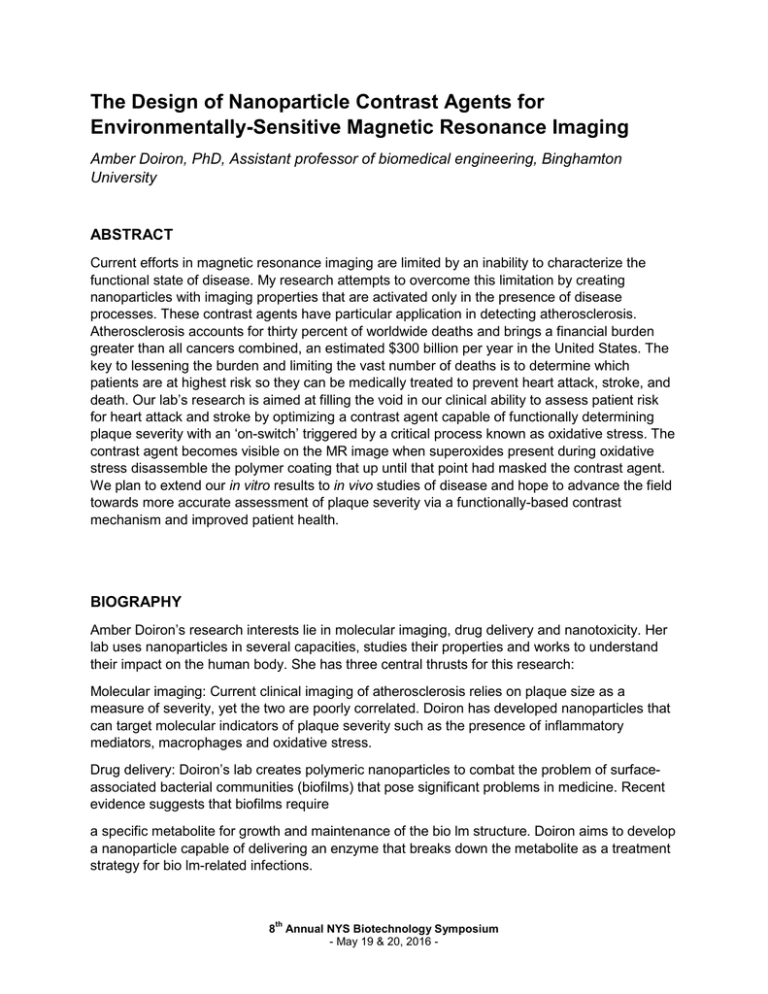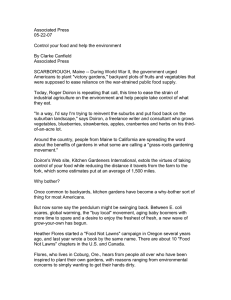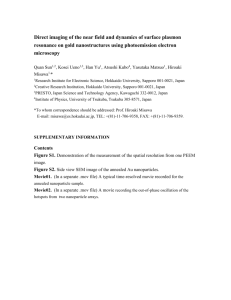The Design of Nanoparticle Contrast Agents for Environmentally-Sensitive Magnetic Resonance Imaging University
advertisement

The Design of Nanoparticle Contrast Agents for Environmentally-Sensitive Magnetic Resonance Imaging Amber Doiron, PhD, Assistant professor of biomedical engineering, Binghamton University ABSTRACT Current efforts in magnetic resonance imaging are limited by an inability to characterize the functional state of disease. My research attempts to overcome this limitation by creating nanoparticles with imaging properties that are activated only in the presence of disease processes. These contrast agents have particular application in detecting atherosclerosis. Atherosclerosis accounts for thirty percent of worldwide deaths and brings a financial burden greater than all cancers combined, an estimated $300 billion per year in the United States. The key to lessening the burden and limiting the vast number of deaths is to determine which patients are at highest risk so they can be medically treated to prevent heart attack, stroke, and death. Our lab’s research is aimed at filling the void in our clinical ability to assess patient risk for heart attack and stroke by optimizing a contrast agent capable of functionally determining plaque severity with an ‘on-switch’ triggered by a critical process known as oxidative stress. The contrast agent becomes visible on the MR image when superoxides present during oxidative stress disassemble the polymer coating that up until that point had masked the contrast agent. We plan to extend our in vitro results to in vivo studies of disease and hope to advance the field towards more accurate assessment of plaque severity via a functionally-based contrast mechanism and improved patient health. BIOGRAPHY Amber Doiron’s research interests lie in molecular imaging, drug delivery and nanotoxicity. Her lab uses nanoparticles in several capacities, studies their properties and works to understand their impact on the human body. She has three central thrusts for this research: Molecular imaging: Current clinical imaging of atherosclerosis relies on plaque size as a measure of severity, yet the two are poorly correlated. Doiron has developed nanoparticles that can target molecular indicators of plaque severity such as the presence of inflammatory mediators, macrophages and oxidative stress. Drug delivery: Doiron’s lab creates polymeric nanoparticles to combat the problem of surfaceassociated bacterial communities (biofilms) that pose significant problems in medicine. Recent evidence suggests that biofilms require a specific metabolite for growth and maintenance of the bio lm structure. Doiron aims to develop a nanoparticle capable of delivering an enzyme that breaks down the metabolite as a treatment strategy for bio lm-related infections. th 8 Annual NYS Biotechnology Symposium - May 19 & 20, 2016 - Nanotoxicity: With the rapid expansion of nanoparticle use in research, manufacturing and consumer products, it’s important to understand the risk of nanoparticle exposure to human health. Doiron’s lab uses in vitro mimics of the vascular endothelium, a critical barrier between blood flow and body tissues, to determine nanoparticle uptake in living systems. Doiron, who earned a doctorate in biomedical engineering from the University of Texas at Austin, completed a post- doctoral fellowship in radiology and chemical engineering at the University of Calgary in Alberta, Canada. She was also the chief scientific officer at NanoPulse Biosciences in Massachusetts for four years. th 8 Annual NYS Biotechnology Symposium - May 19 & 20, 2016 -









